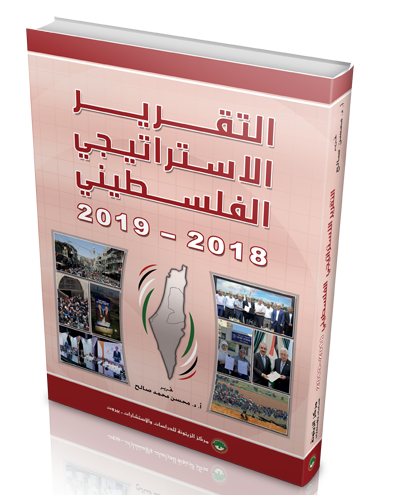Al-Zaytouna Centre for Studies and Consultations in Beirut is offering the Arabic version of the Palestine Strategic Report 2018- 2019 (PSR) for free download. It discusses the Palestine issue during those years, offering a wealth of data, up-to-date statistics and analyses, in addition to an outlook of future events.
The 469-page PSR was edited by Prof. Dr. Mohsen Mohammad Saleh, written by 14 specialized researchers, and reviewed by four consultants. It consists of eight chapters, the most prominent projections for 2020- 2021, and an index.
| >> Free Downlaod: The Palestine Strategic Report 2018- 2019 With the Most Prominent Projections for 2020- 2021 (Arabic) |
|
Publication Information – Title: Al-Taqrir al-Istratiji al-Filastini 2018-2019 (The Palestine Strategic Report 2018- 2019 ). |
 |
The first chapter discusses the internal Palestinian scene, which includes the national consensus government and the Fatah government, the weakness, deterioration and inefficiency of the Palestine Liberation Organization (PLO), the deterioration of the Palestinian Authority (PA), and the dissolution of the Palestine Legislative Council (PLC). It also discusses the Palestinian schism, the status of the Palestinian factions and their popularity, in addition to the popularity indicators and the Palestinian-Israeli security coordination.
The second chapter displayed the Palestinian demographic and economic indicators, which include the Palestinian population worldwide, the demographic characteristics of Palestinians, the demographic growth trends, and Palestinians outside Palestine and the right of return. The chapter discussed also the economic indicators in the West Bank (WB) and the Gaza Strip (GS); Gross domestic product (GDP); GDP per capita, public debt and general budget; Employment, unemployment and poverty; Industrial and agricultural activities and trade; Foreign aid and its effects; in addition to the economic repercussions of the GS siege. It also discussed the outlook for PA economic performance 2020- 2021.
The third chapter is about the Land and the holy sites. It discusses the latest developments concerning Jerusalem, holy sites and settlement expansion, Israeli targeting of Islamic and Christian holy sites, the population in Jerusalem under occupation, Judaization and settlements, Israeli settlement expansion in WB, the Separation Wall and Barriers in WB, demolition of houses and structures, confiscation of lands, and the Israeli exploitation of water resources in WB.
The fourth chapter is about the aggression, resistance and the peace process. It discusses Israeli aggression and Palestinian resistance, Marches of Return and breaking the siege, in addition to Israeli escalation and calm in GS. It reports on the Israeli killed and wounded, the Palestinian killed and wounded in WB and GS, the suffering of Palestinian prisoners and detainees, and the Israeli GS siege. It also discusses the peace process, the Trump administration closure of the PLO office in Washington, the dismantling of the United Nations Relief and Works Agency for Palestine Refugees in the Near East (UNRWA) and the redefinition of the Palestinian refugee, in addition to Trump’s announcement of the peace plan “deal of the century,” and the Palestinian President demand to hold a new “peace” conference.
Chapter five discusses the Israeli scene, including the most prominent Israeli political, demographic, economic and military developments. In addition, it discusses the internal political situation including corruption and Netanyahu’s political future, the rise of the Israeli right, racist laws, Israeli parliamentary Knesset elections, and the conditions of the Palestinians of 1948.
This chapter also explores the Israeli demographic indicators, such as the population of Israel, Jewish immigrants to Israel, world Jewish population, Israeli economic indicators such as Israeli GDP, GDP per Capita, trade, Israel exports and imports, and US aid to Israel. As for the Israeli military indicators, they include appointments and structural changes, manpower, military plans and directions, military maneuvers, arms and arms trade, and the military budget. At the end of the chapter, the Israeli position on the internal Palestinian situation is discussed.
Chapter six discusses the Palestine issue and the Arab world. It explores positions of the League of Arab States concerning the Palestine issue and the schism, the Palestinian reconciliation, the position on the peace process, positions and roles of some key states, such as Egypt, Jordan, Syria, Lebanon, Saudi Arabia, GCC countries, and others. It also discusses developments concerning political and economic normalization of some Arab countries with Israel, in addition to the popular Arab position and its trends.
As for chapter seven, it is about the Palestine issue and the Muslim world. It discusses the policy of the Organisation of Islamic Cooperation (OIC) and other Muslim countries towards the Palestine issue. The Turkish interest in Palestine besides its tension and interests with Israel, in addition to the Turkish political and economic relations with Israeli and Palestinian parties. Iran’s position on the “deal of the century,” Iranian fundamentals concerning the Palestine issue and its relations with Palestinian resistance factions are also discussed, in addition to the responsiveness of the Muslim public to the Palestine issue, and the normalization and Israeli relations with various Muslim Countries.
The eighth chapter, which is the last one, discusses the Palestine issue and the International scene. It studies the stances of the Quartet, UN and international organizations, in addition to positions of the US, EU, BRICS (Brazil, Russia, India, China and South Africa), Japan and other countries towards the Palestine issue. It displays the most important future changes, which may be opportunities or challenges to Israel’s international relations, and finally the chapter offers some recommendations on international support of the Palestine issue.
The PSR is one of al-Zaytouna’s most important academic studies, published periodically in both English and Arabic. Today, it can be surely asserted that PSR is a must reference for every researcher and academic who are interested in the contemporary developments of the Palestine issue. The PSR reviews biennially the various developments concerning the Palestinian question in a comprehensive, objective and academic manner. It offers a wealth of data, up-to-date statistics, and analyzes and offers an outlook of future events with strategic visions.
Read More “Summary of The Palestine Strategic Report 2018-2019”
Read More “The Major Conclusions of the Palestine Strategic Report 2018-2019”
Al-Zaytouna Centre for Studies and Consultations, 17/7/2020
Read More:









Leave A Comment